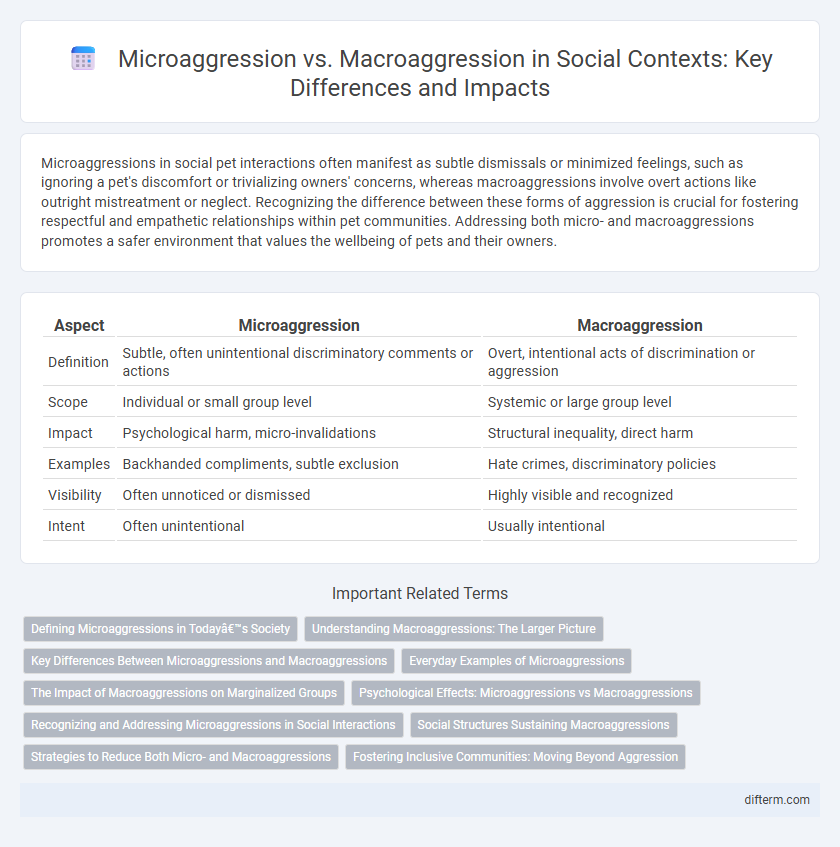Microaggressions in social pet interactions often manifest as subtle dismissals or minimized feelings, such as ignoring a pet's discomfort or trivializing owners' concerns, whereas macroaggressions involve overt actions like outright mistreatment or neglect. Recognizing the difference between these forms of aggression is crucial for fostering respectful and empathetic relationships within pet communities. Addressing both micro- and macroaggressions promotes a safer environment that values the wellbeing of pets and their owners.
Table of Comparison
| Aspect | Microaggression | Macroaggression |
|---|---|---|
| Definition | Subtle, often unintentional discriminatory comments or actions | Overt, intentional acts of discrimination or aggression |
| Scope | Individual or small group level | Systemic or large group level |
| Impact | Psychological harm, micro-invalidations | Structural inequality, direct harm |
| Examples | Backhanded compliments, subtle exclusion | Hate crimes, discriminatory policies |
| Visibility | Often unnoticed or dismissed | Highly visible and recognized |
| Intent | Often unintentional | Usually intentional |
Defining Microaggressions in Today’s Society
Microaggressions are subtle, often unintentional, verbal or nonverbal slights that convey derogatory or negative messages to marginalized groups in everyday interactions. These small, cumulative actions contribute to the perpetuation of systemic inequality and psychological distress among targeted individuals. Understanding microaggressions is essential for fostering inclusive social environments and addressing deeper societal biases.
Understanding Macroaggressions: The Larger Picture
Macroaggressions encompass overt and systemic acts of discrimination that perpetuate inequality and reinforce power imbalances across entire social groups. These large-scale aggressions often manifest in institutional policies, cultural norms, and widespread social practices that marginalize communities based on race, gender, or socioeconomic status. Recognizing macroaggressions is essential for addressing deep-rooted structural injustices beyond individual interactions.
Key Differences Between Microaggressions and Macroaggressions
Microaggressions are subtle, often unintentional, verbal or behavioral slights that communicate derogatory or negative messages to marginalized groups, whereas macroaggressions involve overt, deliberate acts of discrimination or systemic oppression. Microaggressions typically occur in everyday interactions and can cumulatively impact mental health, while macroaggressions manifest as institutional policies or explicit prejudiced actions with broader social consequences. Understanding these distinctions aids in addressing both individual and structural forms of social injustice effectively.
Everyday Examples of Microaggressions
Everyday examples of microaggressions include subtle comments like "You speak English so well" to someone who appears foreign, or assuming a person of color is less qualified in a professional setting. These small, often unintentional acts convey implicit bias and reinforce stereotypes, contributing to cumulative emotional stress. Recognizing microaggressions requires awareness of language, actions, and assumptions that undermine individuals based on race, gender, or other identities.
The Impact of Macroaggressions on Marginalized Groups
Macroaggressions inflict significant psychological harm on marginalized groups by perpetuating systemic inequality and social exclusion. These overt acts of discrimination and hostility undermine mental health, increase stress levels, and contribute to feelings of invisibility and dehumanization. The persistent presence of macroaggressions exacerbates barriers to social mobility, access to resources, and overall community well-being.
Psychological Effects: Microaggressions vs Macroaggressions
Microaggressions, subtle and often unintentional, accumulate psychological stress by causing feelings of invisibility and self-doubt in targeted individuals. Macroaggressions, being overt and intentional acts of discrimination, inflict more immediate and severe trauma, often leading to heightened anxiety, depression, and post-traumatic stress. Both forms of aggression contribute significantly to long-term mental health disparities within marginalized communities.
Recognizing and Addressing Microaggressions in Social Interactions
Microaggressions are subtle, often unintentional acts of discrimination that can cause cumulative harm in social interactions, contrasting with overt and systemic macroaggressions. Recognizing microaggressions involves identifying implicit biases in everyday language and behaviors that marginalize individuals based on race, gender, or other identities. Effective strategies to address microaggressions include promoting awareness through education, encouraging open dialogue, and implementing inclusive practices that foster respect and empathy in social environments.
Social Structures Sustaining Macroaggressions
Social structures such as institutional policies, cultural norms, and systemic inequalities significantly sustain macroaggressions by normalizing discriminatory practices on a large scale. These frameworks perpetuate power imbalances that marginalize minority groups, embedding macroaggressions within education, law enforcement, and workplace environments. Addressing macroaggressions requires dismantling these entrenched social systems through comprehensive reform and equity-focused initiatives.
Strategies to Reduce Both Micro- and Macroaggressions
Implementing comprehensive diversity training programs enhances awareness and sensitivity toward both microaggressions and macroaggressions in social and professional environments. Establishing clear policies that define unacceptable behaviors and enforce consequences can effectively reduce instances of subtle and overt discrimination. Fostering open dialogue and encouraging allyship empower individuals to recognize and challenge aggression, promoting an inclusive and respectful community culture.
Fostering Inclusive Communities: Moving Beyond Aggression
Fostering inclusive communities requires recognizing the impact of both microaggressions and macroaggressions on marginalized groups, which can undermine psychological safety and social cohesion. Implementing comprehensive diversity training programs and promoting open dialogues about implicit biases help create environments where all voices are valued and respected. Emphasizing empathy and active listening supports healing and empowers collective efforts toward equity and belonging.
microaggression vs macroaggression Infographic

 difterm.com
difterm.com